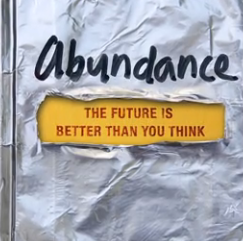
This Sunday the world will celebrate Earth Day once again, but if thoughts of the Earth's future cause you more pessimism than hope, then the new book Abundance may be exactly what you need! The future looks bright to co-writers X-Prize Founder Peter Diamandis and journalist Steven Kotler, who explain how exponentially emerging technologies could address humanity's grand challenges, a thought that should warm any chemical engineer's heart. Although only about two breathless minutes, the short video below elegantly distills the book's core message. And it's obvious that engineers will play a central role in this speculative future. Check out this rapid review by Jason Silva, a former Current TV host turned video-poet proselytizer, who has spent the last three years making bite-sized films he calls shots of "philosophical espresso."
Interview with co-author Peter Diamandis
Still curious about the book and its ideas? Sam Harris interviewed Diamandis and Kotler by email. Here is a short excerpt (whole interview here): Peter Diamandis is a serial entrepreneur turned philanthropist who has started more than a dozen high-tech companies. He has degrees in molecular biology and aerospace engineering from MIT, and an MD from Harvard Medical School. Journalist Steven Kotler's articles have appeared in over 60 publications: including the New York Times Magazine, Wired, Discover, Popular Science, Outside, GQ, and National Geographic. What do you mean by "abundance"?

We believe that over the next two to three decades it will be possible to significantly raise global standards of living. Abundance is not about providing everyone on this planet with a life of luxury--rather it's about providing everyone with a life of possibility. To be able to live such a life requires having the basics covered and then some. It also means stanching some fairly ridiculous bleeding: feeding the hungry, providing access to clean water, ending indoor air pollution, and wiping out malaria--four entirely preventable conditions that kill, respectively, seven, three, three, and two people per minute world-wide. But ultimately, abundance is about creating a world of possibility: a world where everyone's days are spent dreaming and doing, not scrapping and scraping. What makes you think that this is possible? The data for starters. We combed through decades of research, reams of hard facts, and interviewed dozens of scientists, innovators, engineers, and philanthropists. We also see four emerging forces that now beginning to really make their presence felt in the world, but together should enable us to make the equivalent of 200 years of progress over the next 20 years. What are these forces?

Exponential Technologies: Over the past few decades, researchers have come to conclude that any information-based technology is advancing along exponential growth curves. This is why the cell phone in your pocket is as powerful as a mid-70s era supercomputer for a minute fraction of the cost. Besides communication technology, exponential forces are at work in computational and network systems, artificial intelligence, robotics, biotechnology, bio-informatics, nanotechnology, human-machine interfaces, and many more. These technologies will soon enable the vast majority of human beings to experience what only the affluent have had access to thus far. In Abundance, we examine how exponential technologies are being used (and can be used) to provide 7 billion people with clean water, nutritious food, affordable housing, personalized education, top-tier medical care, non-polluting and ubiquitous energy. DIY Innovators: DIY innovators are individuals and small groups empowered by exponential technologies and driven by the desire to take on humanity's grand challenges. As we explore in the book, these groups now have the ability to tackle problems that were once the sole domain of governments and major corporations and NGOs. As a result, we are at the front end of a DIY revolution unlike anything the world has yet seen. Technophilanthropists: Today there are more than 1,400 billionaires and 93,000 "ultra-high-net-worth" individuals in the world. Many of these are young, very socially-conscious entrepreneurs who made their money in technology and are now interested in using it to slay some of the world's grandest challenges. Bill Gates fighting against malaria, Jeff Skoll crusading against pandemics, Pierre Omyidar democracy-spreading efforts. There are many, many more. We call these individuals Technophilanthropists. Rising Billion: These are the poorest people on Earth, the so-called "bottom billion." We have renamed this group the "Rising Billion" because, thanks to the exponential spread of communication and information technologies (like the smart phone), these people are coming on line for the very first time. Their voices, which have never before been heard, are suddenly joining the global conversation. Aided by these technologies, the Rising Billion are beginning to pull themselves out of poverty. They are already on their way to becoming a powerful and significant consuming segment of humanity, and many companies are rushing to develop ultra-low cost products to meet their needs. This effort will drive down the price of basic goods and services in a fashion that will benefit everyone. But the Rising Billion have also become a producing and consuming segment of humanity, generating new ideas, insights, products and services that add to the overall wealth of Earth.



Comments
its interesting how much cell phone technology is helping to change the lives of the RISING BILLION. And there are knock-on effects - forcing a move to solar in India because running cell base stations on diesel is proving to be too expensive. Once this technology is up and running, it seems to migrate to small nearby villages. India is becoming a test-bed for distributed solar. Interestingly, so the an area of western Canada where "First Nations," the indigenous population, is also moving to off-grid solar. It seems that if you look where traditional energy sources are too expensive or inefficient then you'll see the future at work.